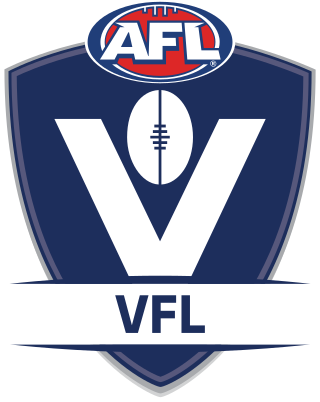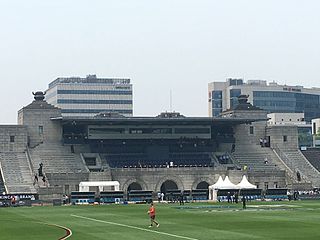Related Research Articles

The Victorian Football League (VFL) is an Australian rules football competition in Australia operated by the Australian Football League (AFL) as a second-tier, regional, semi-professional competition. It includes teams from clubs based in eastern states of Australia: Victoria, New South Wales and Queensland, including reserves teams for the eastern state AFL clubs. It succeeded and continues the competition of the former Victorian Football Association (VFA) which began in 1877. The name of the competition was changed to the Victorian Football League in 1996. Under its VFL brand, the AFL also operates a women's football competition known as VFL Women's, which was established in 2016.

The Williamstown Football Club, nicknamed the Seagulls, is an Australian rules football club based in the Melbourne suburb of Williamstown. The club currently competes in the Victorian Football League (VFL) and VFL Women's (VFLW) competitions.
In the Australian Football League (AFL), previously the Victorian Football League (VFL), the pre-season competition, known during its history by a variety of sponsored names and most recently as the NAB Cup, was an annual Australian rules football tournament held amongst clubs prior to the premiership season between 1988 and 2013. The pre-season competition culminated annually in a grand final and pre-season premier.
Australian rules football attendance records

Australian rules football in China has been played since the 1989 and grew in popularity in the 2010s.
The 1886 Victorian Football Association season was the 10th season of the Australian rules football competition. The premiership was won by the Geelong Football Club. It was the club's seventh VFA premiership, and the last won by its senior team.
Variations of Australian rules football are games or activities based on or similar to the game of Australian rules football, in which the player uses common Australian rules football skills. They range in player numbers from 2 up to the minimum 38 required for a full Australian rules football.

The 1940 VFL Lightning Premiership was an Australian rules football knockout competition played entirely on Saturday, 3 August 1940, at the Melbourne Cricket Ground (MCG). It was played during a week's break of the Victorian Football Leagues's 1940 season between Rounds 14 and 15. It was contested by the 12 teams who competed in the 1940 VFL season. A total of 30,407 witnessed the day's matches. St Kilda won the lighting premiership competition, defeating Richmond in the final by 24 points. It was the first premiership of any kind at any grade that the St Kilda Football Club had won in its history.

The Foxtel Cup was an annual Australian rules football club knockout cup competition involving clubs from state league competitions around Australia. The tournament was organised by the Australian Football League (AFL), and was held annually between 2011 and 2014.
The 2011 Foxtel Cup was the inaugural season of the Australian rules football club knockout cup competition involving clubs from the various state league competitions from around Australia. The first year of the competition also included the AFL's newest expansion side Greater Western Sydney Giants.

The 1907 Victorian Football Association season was the 31st season of the Australian rules football competition. The premiership was won by the Williamstown Football Club, after it defeated West Melbourne in the final by eighteen points. It was the first premiership won by Williamstown, in its 24th season of senior competition.

The 1945 Victorian Football Association season was the 64th season of the Australian rules football competition, and it was the first season played since the Association went into recess during World War II. The premiership was won by the Williamstown Football Club, which defeated Port Melbourne by 37 points in the Grand Final on 6 October. It was the club's fourth VFA premiership.
The 1957 Victorian Football Association season was the 76th season of the Australian rules football competition. The premiership was won by the Moorabbin Football Club, after it defeated Port Melbourne in the Grand Final on 5 October by forty points. It was Moorabbin's first VFA premiership, won in its seventh season of competition. For Port Melbourne, it was the last of eight consecutive Grand Final appearances between 1950 and 1957, of which only the 1953 premiership was won. Minor premiers Williamstown went through the home-and-home season undefeated, but lost both finals to finish third; it was the only premiership which the club did not win between 1954 and 1959.

The 2014 South Australian National Football League season was the 135th season of the South Australian National Football League (SANFL) Australian rules football competition.
The 1977 Victorian Football Association season was the 96th season of the top division of the Australian rules football competition, and the 17th season of second division competition. The Division 1 premiership was won by the Port Melbourne Football Club, after it defeated Sandringham in the Grand Final on 25 September by 100 points; it was Port Melbourne's 12th Division 1 premiership, its second in a row, and the third of six premierships won by the club in nine seasons between 1974 and 1982. The Division 2 premiership was won by Mordialloc; it was the first and only Association premiership in either division ever won by the club.
The 1979 VFA season was the 98th season of the top division of the Victorian Football Association (VFA), an Australian rules football competition based in the state of Victoria, and the 19th season of the VFA's second division.
The 1980 Victorian Football Association season was the 99th season of the top division of the Australian rules football competition, and the 20th season of second division competition. The Division 1 premiership was won by the Port Melbourne Football Club, after it defeated Coburg in the Grand Final on 21 September by eleven points; it was Port Melbourne's 13th Division 1 premiership, the first of three premierships won in a row between 1980 and 1982, and the fourth of six premierships won in nine seasons from 1974 until 1982. The Division 2 premiership was won by Brunswick; it was the club's second Division 2 premiership, and was won in its first season since relegation from Division 1.
The 1983 Victorian Football Association season was the 102nd season of the top division of the Australian rules football competition, and the 23rd season of second division competition. The Division 1 premiership was won by the Preston Football Club, after it defeated Geelong West in the Grand Final on 18 September by seven points; it was Preston's third Division 1 premiership. The Division 2 premiership was won by Springvale; it was the club's first Association premiership, won in only its second season of competition.
Bertram Harold "Bert" Johnson is a former Australian rules footballer who played with West Adelaide in the South Australian National Football League (SANFL) and North Melbourne in the Victorian Football League (VFL).
References
- 1 2 Handby, Jim (12 July 1940). "Prospects in Lightning Premiership". The Advertiser. Adelaide, SA. p. 14.
- ↑ "Chess and Draughts: gathering of players an interesting function". The West Australian. Perth, WA. 15 July 1909. p. 9.
- ↑ Half, Scrum (10 August 1945). "Seven-a-side Rugby Lightning Premiership Tomorrow". The Advertiser. Adelaide, SA. p. 11.
- ↑ "NAB Cup Fixture Released". Port Adelaide Football Club. 26 October 2011. Retrieved 15 December 2011.
- ↑ "NAB Cup 2011 new rule trials". World Footy News. 14 December 2010. Retrieved 15 December 2011.
- ↑ "New rules for NAB Cup". Australian Football League. 24 November 2011. Archived from the original on 19 January 2012. Retrieved 15 December 2011.
- ↑ "Football". The Argus. Melbourne. 2 June 1896. p. 3.
- ↑ Rover (15 July 1940). "Lightning Football Carnival raises more than £1000 for patriotic and charitable funds". The Advertiser. Adelaide, SA. p. 7.
- ↑ Taylor, Percy (2 August 1940). "Unique competition". The Argus. Melbourne. p. 14.
- ↑ "Second Lightning Premiership in South". Examiner. Launceston, TAS. 8 September 1941. p. 7.
- ↑ "Carnival success at Western Oval". The Barrier Miner. Broken Hill, NSW. 6 July 1940. p. 1.
- ↑ "Lightning Premiership". Williamstown Chronicle. Williamstown, VIC. p. 3.
- 1 2 "Williamstown win lightning premiership". Williamstown Chronicle. Williamstown, VIC. 5 July 1946. p. 2.
- 1 2 "Lightning Premiership Won By Ulverstone". The Mercury. Hobart, TAS. 2 July 1951. p. 15.
- ↑ "Lightning N.T.F.A. Premiership". Examiner. Launceston, TAS. 17 March 1953. p. 15.
- ↑ Devaney, John. "1971 Rothmans Channel 7 Cup". Fullpointsfooty. Archived from the original on 7 June 2011. Retrieved 12 December 2011.
{{cite web}}: CS1 maint: unfit URL (link) - ↑ "History of the VFL 1877 - 2009". Sportingpulse. Retrieved 12 December 2011.
- ↑ "Australian Football International Cups". World Footy News. 16 September 2011. Retrieved 15 December 2011.
- ↑ Edmund, Sam (30 April 2011). "Red heart's stronger pulse". Herald Sun. Retrieved 15 December 2011.
- ↑ O'Meara, Patrick (1 March 2011). "Riddell forced to take on favourites". Sunbury Leader. Archived from the original on 23 April 2012. Retrieved 15 December 2011.
- ↑ Observer (8 June 1896). "Football – The charity matches". The Argus. Melbourne. p. 6.
- 1 2 3 "Lightning Premiership Carnival". The Advertiser. Adelaide, SA. 7 June 1946. p. 5.
- 1 2 3 Kneebone, Harry (26 June 1950). "Sturt wins Fourth Lightning Premiership". The Advertiser. Adelaide, SA. p. 6.
- ↑ Kneebone, Harry (7 June 1948). "Port Adelaide Win in Lightning Carnival". The Advertiser. Adelaide, SA. p. 4.
- ↑ Geoffrey Fithall (25 September 1972). "'Big Bob' retires as player". The Age. Melbourne.
- ↑ John Holland (24 September 1973). "Prahran by 35 points". The Age. Melbourne. p. 22.
- ↑ Tom Jacob (23 September 1974). "Vintage Port – here's cheers". The Age. Melbourne. p. 21.
- ↑ Ken Piesse (22 September 1975). "Roosters unruffled". The Age. Melbourne. p. 27.
- ↑ Marc Fiddian (20 September 1976). "Cook all heart in Port win". The Age. Melbourne. p. 31.
- ↑ Marc Fiddian (26 September 1977). "Port's cup full". The Age. Melbourne. p. 31.
- ↑ Marc Fiddian (25 September 1978). "Prahran steps on the Bullants". The Age. Melbourne. p. 27.
- ↑ Marc Fiddian (24 September 1979). "At last the Lions roar". The Age. Melbourne. p. 29.